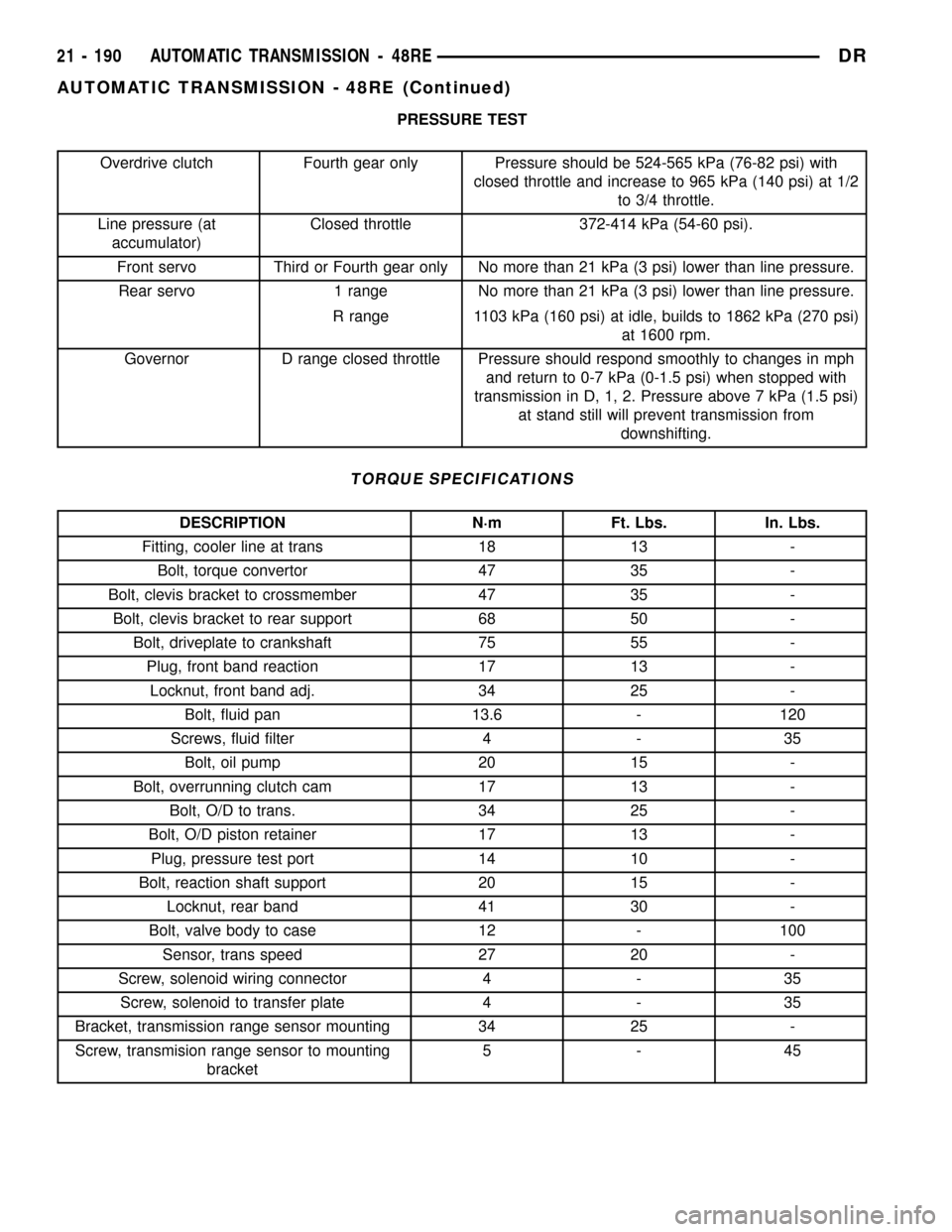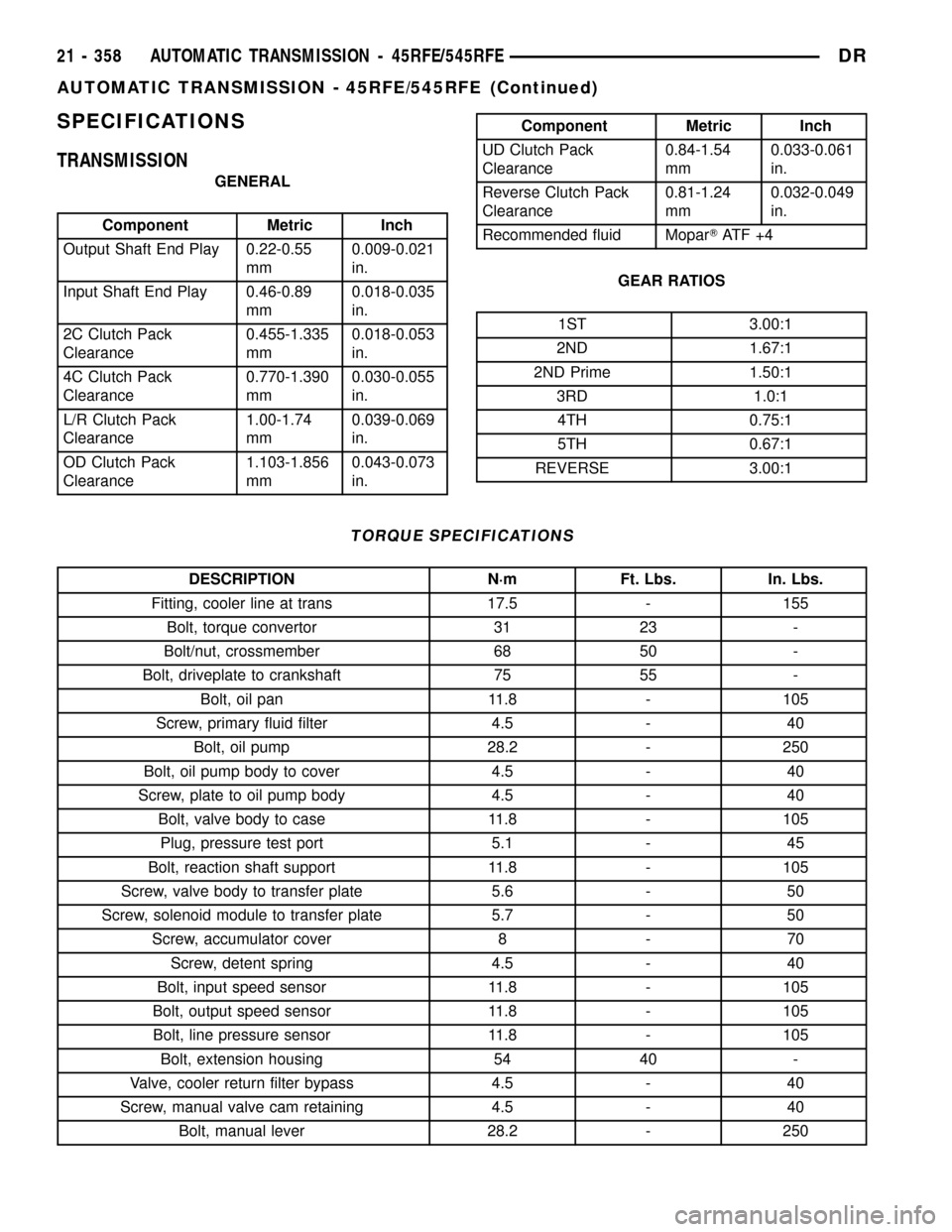1998 DODGE RAM 1500 Crank sensor
[x] Cancel search: Crank sensorPage 1877 of 2627

(9) Install the two screws to hold the TRS to the
mounting bracket. Tighten the screws to 5 N´m (45
in.lbs.).
(10) Verify proper sensor operation (Fig. 62).
(11) Move the transmission manual shaft lever to
the PARK position.
(12) Install torque converter. Use C-clamp or metal
strap to hold converter in place for installation.
BAND ADJUSTMENT AND FINAL
(1) Adjust front and rear bands as follows:
(a) Loosen locknut on each band adjusting screw
4-5 turns.
(b) Tighten both adjusting screws to 8 N´m (72
in. lbs.).
(c) Back off front band adjusting screw 1-3/4
turns.
(d) Back off rear band adjusting screw 3 turns.
(e) Hold each adjusting screw in position and
tighten locknut to 34 N´m (25 ft. lbs.) torque.
(2) Install magnet in oil pan. Magnet seats on
small protrusion at corner of pan.
(3) Position new oil pan gasket on case and install
oil pan. Tighten pan bolts to 13.6 N´m (125 in. lbs.).
(4) Install throttle valve and shift selector levers
on valve body manual lever shaft.
(5) Apply small quantity of dielectric grease to ter-
minal pins of solenoid case connector and neutral
switch.
(6) Fill transmission with recommended fluid.
INSTALLATION
(1) Check torque converter hub inner and outer
diameters and hub drive notches for sharp edgesburrs, scratches, or nicks. Polish the hub and notches
with 320/400 grit paper and crocus cloth if necessary.
The hub must be smooth to avoid damaging pump
seal at installation.
(2) Lubricate pocket in the rear oil pump seal lip
with transmission fluid.
(3) Lubricate converter pilot hub of the crankshaft
with a light coating of MopartHigh Temp Grease.
(4) Align and install converter in oil pump.
(5) Carefully insert converter in oil pump. Then
rotate converter back and forth until fully seated in
pump gears.
(6) Check converter seating with steel scale and
straightedge (Fig. 63). Surface of converter lugs
should be 19mm (0.75 in.) to rear of straightedge
when converter is fully seated.
(7) Temporarily secure converter with C-clamp.
(8) Position transmission on jack and secure it
with chains.
(9) Check condition of converter driveplate.
Replace the plate if cracked, distorted or damaged.
Also be sure transmission dowel pins are seated
in engine block and protrude far enough to
hold transmission in alignment.
(10) Raise transmission and align converter with
drive plate and converter housing with engine block.
(11) Move transmission forward. Then raise, lower
or tilt transmission to align converter housing with
engine block dowels.
(12) Carefully work transmission forward and over
engine block dowels until converter hub is seated in
crankshaft.
Fig. 62 Transmission Range Sensor Operation
1 - NEUTRAL CONTACT
2 - MANUAL LEVER AND SENSOR PLUNGER IN REVERSE
POSITION
3 - PARK CONTACT
4 - TRANSMISSION RANGE SENSOR
Fig. 63 Checking Converter Seating - Typical
1 - SCALE
2 - STRAIGHTEDGE
21 - 174 AUTOMATIC TRANSMISSION - 48REDR
AUTOMATIC TRANSMISSION - 48RE (Continued)
Page 1878 of 2627

(13) Install bolts attaching converter housing to
engine.
(14) Install rear support.
(15) Install the rear transmission crossmember.
(16) Lower transmission onto crossmember and
install bolts attaching transmission mount to cross-
member.
(17) Remove engine support fixture.
(18) Install the transfer case, if equipped.
(19) Install crankshaft position sensor. (Refer to 14
- FUEL SYSTEM/FUEL INJECTION/CRANKSHAFT
POSITION SENSOR - INSTALLATION)
(20) Connect gearshift cable (Fig. 64) and throttle
cable to transmission.
(21) Connect wires to the transmission range sen-
sor and transmission solenoid connector. Be sure the
transmission harnesses are properly routed.
CAUTION: It is essential that correct length bolts be
used to attach the converter to the driveplate. Bolts
that are too long will damage the clutch surface
inside the converter.(22) Install torque converter-to-driveplate bolts.
(23) Install converter housing access cover.
(24) Install starter motor and cooler line bracket.
(Refer to 8 - ELECTRICAL/STARTING/STARTER
MOTOR - INSTALLATION)
(25) Connect cooler lines (Fig. 65) to transmission.
(26) Install transmission fill tube. Install new seal
on tube before installation.
(27) Install any exhaust components previously
removed.
(28) Align and connect propeller shaft. (Refer to 3 -
DIFFERENTIAL & DRIVELINE/PROPELLER
SHAFT/PROPELLER SHAFT - INSTALLATION)
(29) Adjust gearshift cable and throttle valve
cable, if necessary.
(30) Install the transfer case skid plate, if
equipped.
(31) Lower vehicle.
(32) Fill transmission with MopartATF +4, Auto-
matic Transmission fluid.
Fig. 64 Gearshift Cable At Transmission
1 - GEARSHIFT CABLE
2 - TRANSMISSION MANUAL LEVER
3 - CABLE SUPPORT BRACKET
Fig. 65 Transmission Cooler Lines
1 - TRANSMISSION
2 - RADIATOR
3 - COOLER LINES
DRAUTOMATIC TRANSMISSION - 48RE 21 - 175
AUTOMATIC TRANSMISSION - 48RE (Continued)
Page 1893 of 2627

PRESSURE TEST
Overdrive clutch Fourth gear only Pressure should be 524-565 kPa (76-82 psi) with
closed throttle and increase to 965 kPa (140 psi) at 1/2
to 3/4 throttle.
Line pressure (at
accumulator)Closed throttle 372-414 kPa (54-60 psi).
Front servo Third or Fourth gear only No more than 21 kPa (3 psi) lower than line pressure.
Rear servo 1 range No more than 21 kPa (3 psi) lower than line pressure.
R range 1103 kPa (160 psi) at idle, builds to 1862 kPa (270 psi)
at 1600 rpm.
Governor D range closed throttle Pressure should respond smoothly to changes in mph
and return to 0-7 kPa (0-1.5 psi) when stopped with
transmission in D, 1, 2. Pressure above 7 kPa (1.5 psi)
at stand still will prevent transmission from
downshifting.
TORQUE SPECIFICATIONS
DESCRIPTION N´m Ft. Lbs. In. Lbs.
Fitting, cooler line at trans 18 13 -
Bolt, torque convertor 47 35 -
Bolt, clevis bracket to crossmember 47 35 -
Bolt, clevis bracket to rear support 68 50 -
Bolt, driveplate to crankshaft 75 55 -
Plug, front band reaction 17 13 -
Locknut, front band adj. 34 25 -
Bolt, fluid pan 13.6 - 120
Screws, fluid filter 4 - 35
Bolt, oil pump 20 15 -
Bolt, overrunning clutch cam 17 13 -
Bolt, O/D to trans. 34 25 -
Bolt, O/D piston retainer 17 13 -
Plug, pressure test port 14 10 -
Bolt, reaction shaft support 20 15 -
Locknut, rear band 41 30 -
Bolt, valve body to case 12 - 100
Sensor, trans speed 27 20 -
Screw, solenoid wiring connector 4 - 35
Screw, solenoid to transfer plate 4 - 35
Bracket, transmission range sensor mounting 34 25 -
Screw, transmision range sensor to mounting
bracket5-45
21 - 190 AUTOMATIC TRANSMISSION - 48REDR
AUTOMATIC TRANSMISSION - 48RE (Continued)
Page 2022 of 2627

(10) Remove the starter motor.
(11) Rotate crankshaft in clockwise direction until
converter bolts are accessible. Then remove bolts one
at a time. Rotate crankshaft with socket wrench on
dampener bolt.
(12) Disengage the output speed sensor connector
from the output speed sensor (Fig. 9).
(13) Disengage the input speed sensor connector
from the input speed sensor (Fig. 10).(14) Disengage the transmission solenoid/TRS
assembly connector from the transmission solenoid/
TRS assembly (Fig. 11).
(15) Disengage the line pressure sensor connector
from the line pressure sensor (Fig. 12).
Fig. 9 Disconnect Output Speed Sensor
1 - TRANSMISSION
2 - OUTPUT SPEED SENSOR
Fig. 10 Disconnect Input Speed Sensor
1 - TRANSMISSION
2 - INPUT SPEED SENSOR
Fig. 11 Disconnect Transmission Solenoid/TRS
Assembly
1 - TRANSMISSION
2 - TRANSMISSION SOLENOID/TRS ASSEMBLY
Fig. 12 Disconnect Line Pressure Sensor
1 - TRANSMISSION
2 - LINE PRESSURE SENSOR
DRAUTOMATIC TRANSMISSION - 45RFE/545RFE 21 - 319
AUTOMATIC TRANSMISSION - 45RFE/545RFE (Continued)
Page 2037 of 2627

o-ring is properly installed and is free of any debris.
The hub must be smooth to avoid damaging pump
seal at installation.
(2) If a replacement transmission is being
installed, transfer any components necessary, such as
the manual shift lever and shift cable bracket, from
the original transmission onto the replacement trans-
mission.
(3) Lubricate oil pump seal lip with transmission
fluid.
(4) Align converter and oil pump.(5) Carefully insert converter in oil pump. Then
rotate converter back and forth until fully seated in
pump gears.
(6) Check converter seating with steel scale and
straightedge (Fig. 53). Surface of converter lugs
should be at least 13mm (1/2 in.) to rear of straight-
edge when converter is fully seated.
(7) Temporarily secure converter with C-clamp.
(8) Position transmission on jack and secure it
with chains.
(9) Check condition of converter driveplate.
Replace the plate if cracked, distorted or damaged.
Also be sure transmission dowel pins are seated
in engine block and protrude far enough to
hold transmission in alignment.
(10) Apply a light coating of MopartHigh Temp
Grease to the torque converter hub pocket in the rear
pocket of the engine's crankshaft.
(11) Raise transmission (Fig. 54) and align the
torque converter with the drive plate and transmis-
sion converter housing with the engine block.
(12) Move transmission forward. Then raise, lower
or tilt transmission to align the converter housing
with engine block dowels.
(13) Carefully work transmission forward and over
engine block dowels until converter hub is seated in
crankshaft. Verify that no wires, or the transmission
vent hose, have become trapped between the engine
block and the transmission.
(14) Install two bolts to attach the transmission to
the engine.
(15) Install remaining torque converter housing to
engine bolts. Tighten to 68 N´m (50 ft.lbs.).
Fig. 51 Install Primary Oil and Cooler Filters
1 - PRIMARY OIL FILTER
2 - COOLER RETURN FILTER
3 - COOLER RETURN FILTER BYPASS VALVE
4 - VALVE BODY
Fig. 52 Install Input, Output, and Line Pressure
Sensors
1 - OUTPUT SPEED SENSOR
2 - LINE PRESSURE SENSOR
3 - INPUT SPEED SENSOR
Fig. 53 Checking Torque Converter Seating - Typical
1 - SCALE
2 - STRAIGHTEDGE
21 - 334 AUTOMATIC TRANSMISSION - 45RFE/545RFEDR
AUTOMATIC TRANSMISSION - 45RFE/545RFE (Continued)
Page 2061 of 2627

SPECIFICATIONS
TRANSMISSION
GENERAL
Component Metric Inch
Output Shaft End Play 0.22-0.55
mm0.009-0.021
in.
Input Shaft End Play 0.46-0.89
mm0.018-0.035
in.
2C Clutch Pack
Clearance0.455-1.335
mm0.018-0.053
in.
4C Clutch Pack
Clearance0.770-1.390
mm0.030-0.055
in.
L/R Clutch Pack
Clearance1.00-1.74
mm0.039-0.069
in.
OD Clutch Pack
Clearance1.103-1.856
mm0.043-0.073
in.
Component Metric Inch
UD Clutch Pack
Clearance0.84-1.54
mm0.033-0.061
in.
Reverse Clutch Pack
Clearance0.81-1.24
mm0.032-0.049
in.
Recommended fluid MoparTAT F + 4
GEAR RATIOS
1ST 3.00:1
2ND 1.67:1
2ND Prime 1.50:1
3RD 1.0:1
4TH 0.75:1
5TH 0.67:1
REVERSE 3.00:1
TORQUE SPECIFICATIONS
DESCRIPTION N´m Ft. Lbs. In. Lbs.
Fitting, cooler line at trans 17.5 - 155
Bolt, torque convertor 31 23 -
Bolt/nut, crossmember 68 50 -
Bolt, driveplate to crankshaft 75 55 -
Bolt, oil pan 11.8 - 105
Screw, primary fluid filter 4.5 - 40
Bolt, oil pump 28.2 - 250
Bolt, oil pump body to cover 4.5 - 40
Screw, plate to oil pump body 4.5 - 40
Bolt, valve body to case 11.8 - 105
Plug, pressure test port 5.1 - 45
Bolt, reaction shaft support 11.8 - 105
Screw, valve body to transfer plate 5.6 - 50
Screw, solenoid module to transfer plate 5.7 - 50
Screw, accumulator cover 8 - 70
Screw, detent spring 4.5 - 40
Bolt, input speed sensor 11.8 - 105
Bolt, output speed sensor 11.8 - 105
Bolt, line pressure sensor 11.8 - 105
Bolt, extension housing 54 40 -
Valve, cooler return filter bypass 4.5 - 40
Screw, manual valve cam retaining 4.5 - 40
Bolt, manual lever 28.2 - 250
21 - 358 AUTOMATIC TRANSMISSION - 45RFE/545RFEDR
AUTOMATIC TRANSMISSION - 45RFE/545RFE (Continued)
Page 2564 of 2627

Immediately after a cold start, between predeter-
mined temperature thresholds limits, the three port
solenoid is briefly energized. This initializes the
pump by drawing air into the pump cavity and also
closes the vent seal. During non test conditions the
vent seal is held open by the pump diaphragm
assembly which pushes it open at the full travel posi-
tion. The vent seal will remain closed while the
pump is cycling due to the reed switch triggering of
the three port solenoid that prevents the diaphragm
assembly from reaching full travel. After the brief
initialization period, the solenoid is de-energized
allowing atmospheric pressure to enter the pump
cavity, thus permitting the spring to drive the dia-
phragm which forces air out of the pump cavity and
into the vent system. When the solenoid is energized
and de energized, the cycle is repeated creating flow
in typical diaphragm pump fashion. The pump is con-
trolled in 2 modes:
Pump Mode: The pump is cycled at a fixed rate to
achieve a rapid pressure build in order to shorten the
overall test length.
Test Mode: The solenoid is energized with a fixed
duration pulse. Subsequent fixed pulses occur when
the diaphragm reaches the Switch closure point.
The spring in the pump is set so that the system
will achieve an equalized pressure of about 7.5º H20.
The cycle rate of pump strokes is quite rapid as the
system begins to pump up to this pressure. As the
pressure increases, the cycle rate starts to drop off. If
there is no leak in the system, the pump would even-
tually stop pumping at the equalized pressure. If
there is a leak, it will continue to pump at a rate rep-
resentative of the flow characteristic of the size of the
leak. From this information we can determine if the
leak is larger than the required detection limit (cur-
rently set at .040º orifice by CARB). If a leak is
revealed during the leak test portion of the test, the
test is terminated at the end of the test mode and no
further system checks will be performed.
After passing the leak detection phase of the test,
system pressure is maintained by turning on the
LDP's solenoid until the purge system is activated.
Purge activation in effect creates a leak. The cycle
rate is again interrogated and when it increases due
to the flow through the purge system, the leak check
portion of the diagnostic is complete.
The canister vent valve will unseal the system
after completion of the test sequence as the pump
diaphragm assembly moves to the full travel position.
Evaporative system functionality will be verified by
using the stricter evap purge flow monitor. At an
appropriate warm idle the LDP will be energized to
seal the canister vent. The purge flow will be clocked
up from some small value in an attempt to see a
shift in the 02 control system. If fuel vapor, indicatedby a shift in the 02 control, is present the test is
passed. If not, it is assumed that the purge system is
not functioning in some respect. The LDP is again
turned off and the test is ended.
MISFIRE MONITOR
Excessive engine misfire results in increased cata-
lyst temperature and causes an increase in HC emis-
sions. Severe misfires could cause catalyst damage.
To prevent catalytic convertor damage, the PCM
monitors engine misfire.
The Powertrain Control Module (PCM) monitors
for misfire during most engine operating conditions
(positive torque) by looking at changes in the crank-
shaft speed. If a misfire occurs the speed of the
crankshaft will vary more than normal.
FUEL SYSTEM MONITOR
To comply with clean air regulations, vehicles are
equipped with catalytic converters. These converters
reduce the emission of hydrocarbons, oxides of nitro-
gen and carbon monoxide. The catalyst works best
when the Air Fuel (A/F) ratio is at or near the opti-
mum of 14.7 to 1.
The PCM is programmed to maintain the optimum
air/fuel ratio of 14.7 to 1. This is done by making
short term corrections in the fuel injector pulse width
based on the O2S sensor output. The programmed
memory acts as a self calibration tool that the engine
controller uses to compensate for variations in engine
specifications, sensor tolerances and engine fatigue
over the life span of the engine. By monitoring the
actual fuel-air ratio with the O2S sensor (short term)
and multiplying that with the program long-term
(adaptive) memory and comparing that to the limit,
it can be determined whether it will pass an emis-
sions test. If a malfunction occurs such that the PCM
cannot maintain the optimum A/F ratio, then the
MIL will be illuminated.
CATALYST MONITOR
To comply with clean air regulations, vehicles are
equipped with catalytic converters. These converters
reduce the emission of hydrocarbons, oxides of nitro-
gen and carbon monoxide.
Normal vehicle miles or engine misfire can cause a
catalyst to decay. This can increase vehicle emissions
and deteriorate engine performance, driveability and
fuel economy.
The catalyst monitor uses dual oxygen sensors
(O2S's) to monitor the efficiency of the converter. The
dual O2S's sensor strategy is based on the fact that
as a catalyst deteriorates, its oxygen storage capacity
and its efficiency are both reduced. By monitoring
the oxygen storage capacity of a catalyst, its effi-
ciency can be indirectly calculated. The upstream
DREMISSIONS CONTROL 25 - 3
EMISSIONS CONTROL (Continued)
Page 2590 of 2627

BALL JOINT - DIAGNOSIS AND TESTING,
LOWER.........................2-19,2-34
BALL JOINT - DIAGNOSIS AND TESTING,
UPPER..........................2-27,2-36
BALL JOINT - INSTALLATION, LOWER . 2-20,2-35
BALL JOINT - INSTALLATION, UPPER.....2-36
BALL JOINT - REMOVAL, LOWER.....2-19,2-35
BALL JOINT - REMOVAL, UPPER.........2-36
BAND OPERATION - DIAGNOSIS AND
TESTING, AIR TESTING
TRANSMISSION CLUTCH.............21-144
BANDS - ADJUSTMENT...............21-195
BANDS - DESCRIPTION...............21-194
BANDS - OPERATION................21-194
BAR - DESCRIPTION, STABILIZER........2-24
BAR - DESCRIPTION, TORSION..........2-26
BAR - INSTALLATION, STABILIZER....2-25,2-40
BAR - INSTALLATION, TORSION..........2-27
BAR - INSTALLATION, TRACK...........19-38
BAR - OPERATION, STABILIZER..........2-25
BAR - OPERATION, TORSION............2-26
BAR - REMOVAL, STABILIZER.......2-25,2-39
BAR - REMOVAL, TORSION.............2-26
BAR - REMOVAL, TRACK..............19-38
BAR CROSS MEMBER BUSHING -
INSTALLATION, TORSION...............2-15
BAR CROSSMEMBER BUSHING -
REMOVAL, TORSION...................2-13
BASE BRAKE, SPECIFICATIONS...........5-10
BASE BRAKE SYSTEM - DIAGNOSIS AND
TESTING.............................5-2
BASE BRAKES, SPECIAL TOOLS...........5-5
BASECOAT/CLEARCOAT FINISH -
DESCRIPTION.......................23-73
BATTERIES - STANDARD PROCEDURE,
RKE TRANSMITTER...................8N-8
BATTERY - DESCRIPTION...............8F-7
BATTERY - DIAGNOSIS AND TESTING.....8F-7
BATTERY CABLES - DESCRIPTION.......8F-14
BATTERY CABLES - DIAGNOSIS AND
TESTING...........................8F-15
BATTERY CABLES - INSTALLATION.......8F-17
BATTERY CABLES - OPERATION.........8F-15
BATTERY CABLES - REMOVAL..........8F-16
BATTERY CHARGING - STANDARD
PROCEDURE.........................8F-8
BATTERY HOLDDOWN - DESCRIPTION....8F-14
BATTERY HOLDDOWN - INSTALLATION . . . 8F-14
BATTERY HOLDDOWN - OPERATION.....8F-14
BATTERY HOLDDOWN - REMOVAL.......8F-14
BATTERY SYSTEM - CLEANING...........8F-5
BATTERY SYSTEM - DESCRIPTION........8F-1
BATTERY SYSTEM - DIAGNOSIS AND
TESTING............................8F-2
BATTERY SYSTEM - INSPECTION.........8F-5
BATTERY SYSTEM - OPERATION.........8F-2
BATTERY SYSTEM - SPECIFICATIONS......8F-6
BATTERY SYSTEM SPECIAL TOOLS,
SPECIAL TOOLS......................8F-7
BATTERY TEMPERATURE SENSOR -
DESCRIPTION.......................8F-21
BATTERY TEMPERATURE SENSOR -
INSTALLATION.......................8F-21
BATTERY TEMPERATURE SENSOR -
OPERATION.........................8F-21
BATTERY TEMPERATURE SENSOR -
REMOVAL..........................8F-21
BATTERY TESTER - STANDARD
PROCEDURE, USING MICRO 420........8F-12
BATTERY TRAY - DESCRIPTION.........8F-17
BATTERY TRAY - INSTALLATION.........8F-18
BATTERY TRAY - OPERATION...........8F-17
BATTERY TRAY - REMOVAL............8F-17
BEAM INDICATOR - DESCRIPTION, HIGH . . 8J-28
BEAM INDICATOR - OPERATION, HIGH....8J-28
BEARING - ADJUSTMENTS, CENTER.......3-9
BEARING - FITTING - STANDARD
PROCEDURE, CRANKSHAFT MAIN . . 9-134,9-207
BEARING - INSTALLATION, CENTER........3-9
BEARING - INSTALLATION, CLUTCH
RELEASE............................6-10
BEARING - INSTALLATION, HUB
..........2-32
BEARING - INSTALLATION, OUTPUT
SHAFT FRONT
......................21-216
BEARING - INSTALLATION, OUTPUT
SHAFT REAR
.......................21-217
BEARING - INSTALLATION, PILOT
........6-12
BEARING - REMOVAL, CENTER
...........3-9BEARING - REMOVAL, CLUTCH RELEASE . . . 6-9
BEARING - REMOVAL, HUB.............2-31
BEARING - REMOVAL, OUTPUT SHAFT
FRONT............................21-216
BEARING - REMOVAL, OUTPUT SHAFT
REAR.............................21-216
BEARING - REMOVAL, PILOT............6-11
BEARING AND CRANKSHAFT JOURNAL
CLEARANCE - STANDARD
PROCEDURE, CONNECTING ROD........9-272
BEARING CLEARANCE - STANDARD
PROCEDURE, MAIN...................9-274
BEARING FITTING - STANDARD
PROCEDURE, CONNECTING ROD........9-129
BEARING FITTING, STANDARD
PROCEDURE - CONNECTING ROD........9-49
BEARING FITTING, STANDARD
PROCEDURE - MAIN...................9-44
BEARINGS - INSPECTION, CRANKSHAFT
MAIN.........................9-135,9-208
BEARINGS - INSTALLATION, AXLE . . 3-125,3-153,
3-44,3-95
BEARINGS - INSTALLATION, CAMSHAFT . . 9-271
BEARINGS - INSTALLATION,
DIFFERENTIAL CASE . . . 3-106,3-134,3-161,3-48,
3-75
BEARINGS - REMOVAL, AXLE . 3-125,3-152,3-43,
3-95
BEARINGS - REMOVAL, CAMSHAFT......9-268
BEARINGS - REMOVAL, DIFFERENTIAL
CASE............3-105,3-134,3-161,3-48,3-75
BELT - 3.7L / 4.7L - INSTALLATION,
DRIVE................................7-26
BELT - 3.7L / 4.7L - REMOVAL, DRIVE.....7-26
BELT - 5.9L DIESEL - INSTALLATION,
DRIVE..............................7-29
BELT - 5.9L DIESEL - REMOVAL, DRIVE....7-29
BELT / CHAIN COVER(S) -
INSTALLATION, TIMING...........9-171,9-81
BELT / CHAIN COVER(S) - REMOVAL,
TIMING........................9-170,9-81
BELT - DIAGNOSIS AND TESTING,
ACCESSORY DRIVE................7-24,7-27
BELT - INSTALLATION, FRONT CENTER
SEAT ..............................8O-31
BELT - REMOVAL, FRONT CENTER SEAT . . 8O-30
BELT & RETRACTOR - INSTALLATION,
FRONT CENTER SEAT.................8O-29
BELT & RETRACTOR - INSTALLATION,
REAR CENTER SEAT..................8O-45
BELT & RETRACTOR - INSTALLATION,
REAR OUTBOARD SEAT...............8O-47
BELT & RETRACTOR - REMOVAL, FRONT
CENTER SEAT.......................8O-29
BELT & RETRACTOR - REMOVAL, REAR
CENTER SEAT.......................8O-44
BELT & RETRACTOR - REMOVAL, REAR
OUTBOARD SEAT....................8O-46
BELT BUCKLE - INSTALLATION, FRONT
OUTBOARD SEAT....................8O-38
BELT BUCKLE - REMOVAL, FRONT
OUTBOARD SEAT....................8O-37
BELT MOLDING - INSTALLATION, FRONT
DOOR INNER........................23-93
BELT MOLDING - INSTALLATION, FRONT
DOOR OUTER.......................23-93
BELT MOLDING - INSTALLATION, REAR
DOOR INNER........................23-94
BELT MOLDING - INSTALLATION, REAR
DOOR OUTER.......................23-94
BELT MOLDING - REMOVAL, FRONT
DOOR INNER........................23-93
BELT MOLDING - REMOVAL, FRONT
DOOR OUTER.......................23-92
BELT MOLDING - REMOVAL, REAR
DOOR INNER........................23-94
BELT MOLDING - REMOVAL, REAR
DOOR OUTER.......................23-93
BELT SWITCH - DESCRIPTION, SEAT.....8O-51
BELT SWITCH - DIAGNOSIS AND
TESTING, SEAT
......................8O-51
BELT SWITCH - OPERATION, SEAT
.......8O-51
BELT TENSION REDUCER -
DESCRIPTION, SEAT
..................8O-53
BELT TENSION REDUCER - DIAGNOSIS
AND TESTING, SEAT
..................8O-54
BELT TENSION REDUCER - OPERATION,
SEAT
..............................8O-54BELT TENSIONER - 3.7L / 4.7L -
DESCRIPTION........................7-21
BELT TENSIONER - 3.7L / 4.7L -
INSTALLATION........................7-22
BELT TENSIONER - 3.7L / 4.7L -
OPERATION..........................7-21
BELT TENSIONER - 3.7L / 4.7L -
REMOVAL...........................7-21
BELT TENSIONER - 5.9L DIESEL -
DESCRIPTION........................7-23
BELT TENSIONER - 5.9L DIESEL -
INSTALLATION........................7-24
BELT TENSIONER - 5.9L DIESEL -
OPERATION..........................7-23
BELT TENSIONER - 5.9L DIESEL -
REMOVAL...........................7-23
BELT TENSIONER - DESCRIPTION, SEAT . . 8O-52
BELT TENSIONER - OPERATION, SEAT....8O-53
BELT TENSIONER-5.7L - DESCRIPTION....7-22
BELT TENSIONER-5.7L - INSTALLATION....7-23
BELT TENSIONER-5.7L - OPERATION......7-22
BELT TENSIONER-5.7L - REMOVAL.......7-22
BELT TURNING LOOP ADJUSTER -
INSTALLATION, SEAT.................8O-55
BELT TURNING LOOP ADJUSTER -
REMOVAL, SEAT.....................8O-55
BELT/CHAIN AND SPROCKETS -
INSPECTION, TIMING.............9-174,9-84
BELT/CHAIN AND SPROCKETS -
INSTALLATION, TIMING...........9-176,9-85
BELT/CHAIN AND SPROCKETS -
REMOVAL, TIMING.................9-172,9-83
BEZEL - INSTALLATION, CLUSTER.......23-49
BEZEL - INSTALLATION, INSTRUMENT
PANEL CENTER......................23-57
BEZEL - INSTALLATION, INSTRUMENT
PANEL DRIVER SIDE..................23-58
BEZEL - INSTALLATION, INSTRUMENT
PANEL HEADLAMP SWITCH............23-56
BEZEL - REMOVAL, CLUSTER...........23-49
BEZEL - REMOVAL, INSTRUMENT PANEL
CENTER............................23-57
BEZEL - REMOVAL, INSTRUMENT PANEL
DRIVER SIDE........................23-58
BEZEL - REMOVAL, INSTRUMENT PANEL
HEADLAMP SWITCH..................23-56
BIN - INSTALLATION, STORAGE.........23-61
BIN - INSTALLATION, UNDER SEAT
STORAGE...........................23-80
BIN - REMOVAL, STORAGE.............23-61
BIN - REMOVAL, UNDER SEAT STORAGE . . 23-80
BIN COVERING - INSTALLATION, UNDER
SEAT STORAGE......................23-80
BIN COVERING - REMOVAL, UNDER
SEAT STORAGE......................23-80
BIN LATCH - INSTALLATION, UNDER
SEAT STORAGE......................23-80
BIN LATCH - REMOVAL, UNDER SEAT
STORAGE...........................23-80
BIN LID - INSTALLATION, UNDER SEAT
STORAGE...........................23-80
BIN LID - REMOVAL, UNDER SEAT
STORAGE...........................23-80
BLADE - DESCRIPTION, WIPER.........8R-18
BLADE - INSTALLATION, WIPER.........8R-20
BLADE - OPERATION, WIPER...........8R-19
BLADE - REMOVAL, WIPER............8R-19
BLEEDING - STANDARD PROCEDURE......5-31
BLEEDING - STANDARD PROCEDURE,
ABS BRAKE..........................5-46
BLEEDING - STANDARD PROCEDURE,
MANUAL.............................5-5
BLEEDING - STANDARD PROCEDURE,
MASTER CYLINDER...................5-26
BLEEDING - STANDARD PROCEDURE,
PRESSURE...........................5-5
BLEND DOOR - INSTALLATION..........24-27
BLEND DOOR - REMOVAL.............24-27
BLEND DOOR ACTUATOR -
DESCRIPTION.......................24-17
BLEND DOOR ACTUATOR -
INSTALLATION.......................24-18
BLEND DOOR ACTUATOR - OPERATION
. . . 24-17
BLEND DOOR ACTUATOR - REMOVAL
....24-17
BLOCK - CLEANING, ENGINE
. . 9-128,9-205,9-39
BLOCK - DESCRIPTION, BLOWER
MOTOR RESISTOR
...................24-18
BLOCK - DESCRIPTION, ENGINE
.....9-128,9-38
DRINDEX 3
Description Group-Page Description Group-Page Description Group-Page